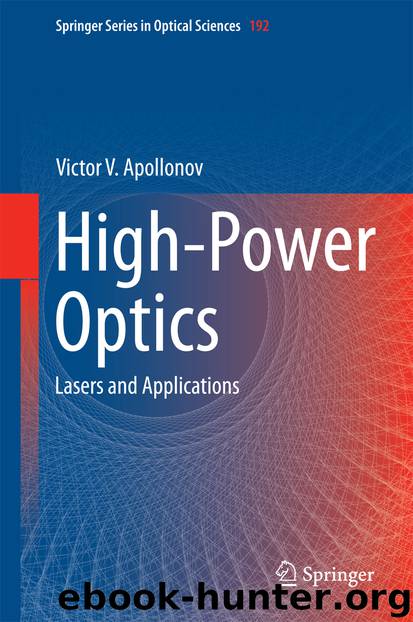High-Power Optics by Victor V. Apollonov

Author:Victor V. Apollonov
Language: eng
Format: epub
Publisher: Springer International Publishing, Cham
15.3 Design and Physical Foundations of Disk Laser Operation
The principle of the disk laser operation is based on the use of an active element in the form of a disk with a cooled surface. High cooling efficiency of the laser medium is provided by a large area of the disk surface, which is important from the point of view of the heat transfer process. Therefore, the average power in the beam can reach quite high values. It is important to note that due to effective heat transfer within the disk area there is no thermal lens effect, characteristic of ‘rod’ and ‘slab’ (optical range) geometries of the active element. In this case, cooling is performed through a side surface of the active element; a two-dimensional heat flow, forming a parabolic profile of thermal distortion, propagates through this side surface. The temperature dependence of the refractive index in this case leads to the emergence of a strong thermal lens effect. Such a lens deteriorates the directivity of the output and significantly limits the effectiveness of its action. The thin disk, in contrast, is cooled through a thin contact region on one side and generates a one-dimensional axial heat flow on the other side. As a result, the temperature gradient is distributed parallel to the laser beam, which does not result in the thermal lens effect. In practice, a thin laser element in high-power disk lasers is either connected to a porous heat sink or is cooled by forced convection [2, 3].
In both cases, the undesirable thermal lenses are eliminated by the optimum layout of structural elements of the disk laser. Integral heat transfer from the active material to the porous heat sink depends directly on the area of the pump zone and on the geometry of the heat transfer contact. At a constant temperature of the active laser element, the average output power achieved is directly proportional to the area of the pump zone and, consequently, to the cross-sectional area of the laser beam on the disk. This is a unique feature of disk lasers, which allows one to change the power density at a constant energy of the beam on the disk. This property is particularly important for multi-kilowatt sources, because it makes it possible to adjust the value of the peak output power without changing many other parameters that affect the performance of the overall system.
At first glance, the basic challenge is the disk thickness needed for efficient heat dissipation, because the conventional scheme involves low absorbance of the active disk material. However, the pump scheme allows one to find an elegant solution to this problem. The process of excitation in the active material of the disk can be represented in the form of multi-channel optical configuration [4, 5] consisting of a parabolic mirror and a pump deflection system. The parabolic mirror focuses a collimated beam of the laser cavity containing an active element. After partial absorption of radiation passing through the disk body, some energy of the beam is reflected from a highly reflective mirror located on the backside of the disk.
Download
This site does not store any files on its server. We only index and link to content provided by other sites. Please contact the content providers to delete copyright contents if any and email us, we'll remove relevant links or contents immediately.
| Concrete | Extraction & Processing |
| Fracture Mechanics | Materials Science |
| Metallurgy | Polymers & Textiles |
| Strength of Materials | Testing |
Whiskies Galore by Ian Buxton(40603)
Introduction to Aircraft Design (Cambridge Aerospace Series) by John P. Fielding(32359)
Small Unmanned Fixed-wing Aircraft Design by Andrew J. Keane Andras Sobester James P. Scanlan & András Sóbester & James P. Scanlan(32154)
Craft Beer for the Homebrewer by Michael Agnew(17467)
Turbulence by E. J. Noyes(7068)
The Complete Stick Figure Physics Tutorials by Allen Sarah(6654)
Kaplan MCAT General Chemistry Review by Kaplan(6078)
The Thirst by Nesbo Jo(5810)
Bad Blood by John Carreyrou(5794)
Learning SQL by Alan Beaulieu(5440)
Weapons of Math Destruction by Cathy O'Neil(5064)
Man-made Catastrophes and Risk Information Concealment by Dmitry Chernov & Didier Sornette(4764)
iGen by Jean M. Twenge(4712)
Digital Minimalism by Cal Newport;(4595)
Life 3.0: Being Human in the Age of Artificial Intelligence by Tegmark Max(4530)
Audition by Ryu Murakami(4117)
Electronic Devices & Circuits by Jacob Millman & Christos C. Halkias(4058)
1,001 ASVAB Practice Questions For Dummies by Powers Rod(4054)
Pale Blue Dot by Carl Sagan(4027)
